 Insolvencies in England and Wales have fallen to their lowest level since 2005, official records show. The Insolvency Service indicates that bankruptcy, individual voluntary arrangements and debt relief orders have fallen, with the largest and worst form of bankruptcy falling by 22.5 per cent compared to the same period in 2014. There has also been a fall in corporate insolvencies back to pre-crisis levels.
Insolvencies in England and Wales have fallen to their lowest level since 2005, official records show. The Insolvency Service indicates that bankruptcy, individual voluntary arrangements and debt relief orders have fallen, with the largest and worst form of bankruptcy falling by 22.5 per cent compared to the same period in 2014. There has also been a fall in corporate insolvencies back to pre-crisis levels.
The British economy is recovering and despite an increase in consumer borrowing of £1.2 billion from February to March, which is the biggest since the onset of the credit crunch, the number of people in financial difficulty and living beyond their means has fallen. However, there are also suggestions that the number could begin to creep up in the future and we are still seeing a divide between the north and south of England in terms of the number of insolvencies.
There are many factors that could explain such a decline in insolvencies. Perhaps it is the growth in wages, in part due the recovery of the economy, which has enabled more people to forgo borrowing or enabled them to repay any loan more comfortably. Lower inflation has helped to reduce the cost of living, thereby increasing the available income to repay any loans. Interest rates have also remained low, thus cutting the cost of borrowing and the repayments due.
But, another factor may simply be that lending is now more closely regulated. Prior to the financial crisis, huge amounts of money were being lent out, often to those who had no chance of making the repayments. More stringent affordability checks by lenders may have a large part to play in reducing the number of insolvencies. President of R3, the insolvency practitioner body, Phillip Sykes said:
“It may be too early to draw conclusions but demand could be falling as a result of low interest rates, low inflation and tighter regulation. This trend is worth watching.”
Mark Sands, from Baker Tilly added to this, noting that fewer people were now in financial difficulty.
“As well as this, we are seeing lower levels of personal debt and fewer people borrowing outside of their means due to more stringent affordability checks by creditors.”
Whatever the main reason behind the data, it is certainly a positive indicator, perhaps of economic recovery, or that at least some have learned the lessons of the financial crisis. The following articles consider this topic.
Personal insolvencies fall to 10-year low Financial Times, James Pickford (1/5/15)
Personal insolvencies at lowest level since 2005 BBC News (29/4/15)
Personal insolvencies drop to lowest level in a decade The Guardian, Press Association (29/4/15)
Corporate insolvencies at lowest level since 2007 The Telegraph, Elizabeth Anderson (30/4/15)
Interview: R3 President Phillip Sykes Accountancy Age, Richard Crump (1/5/15)
North-South gap widens in personal insolvencies Independent, Ben Chu (27/4/15)
Insolvency rates show ‘stark’ north-south divide Financial Times, James Pickford (27/4/15)
Questions
- What is meant by insolvency?
- There are many factors that might explain why the number of insolvencies has fallen. Explain the economic theory behind a lower inflation rate and why this might have contributed to fewer insolvencies.
- How might lower interest rates affect both the number of personal and corporate insolvencies?
- Why has there been a growth in the north-south divide in terms of the number of insolvencies?
- Do you think this data does suggest that lessons have been learned from the Credit Crunch?
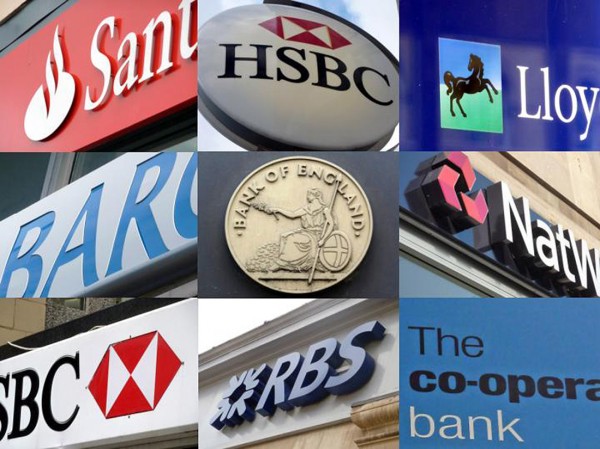 On 15 September 2008, Lehman Brothers, the fourth-largest investment bank in the USA, filed for bankruptcy. Although the credit crisis had been building since mid 2007, the demise of Lehmans was a pivotal event in the unfolding of the financial crisis and the subsequent severe recession in most developed economies. Banks were no longer seen as safe and huge amounts of government money had to be poured into banks to shore up their capital and prevent further bankruptcies. Partial nationalisation seemed the only way of rescuing several banks and with it the global financial system.
On 15 September 2008, Lehman Brothers, the fourth-largest investment bank in the USA, filed for bankruptcy. Although the credit crisis had been building since mid 2007, the demise of Lehmans was a pivotal event in the unfolding of the financial crisis and the subsequent severe recession in most developed economies. Banks were no longer seen as safe and huge amounts of government money had to be poured into banks to shore up their capital and prevent further bankruptcies. Partial nationalisation seemed the only way of rescuing several banks and with it the global financial system.
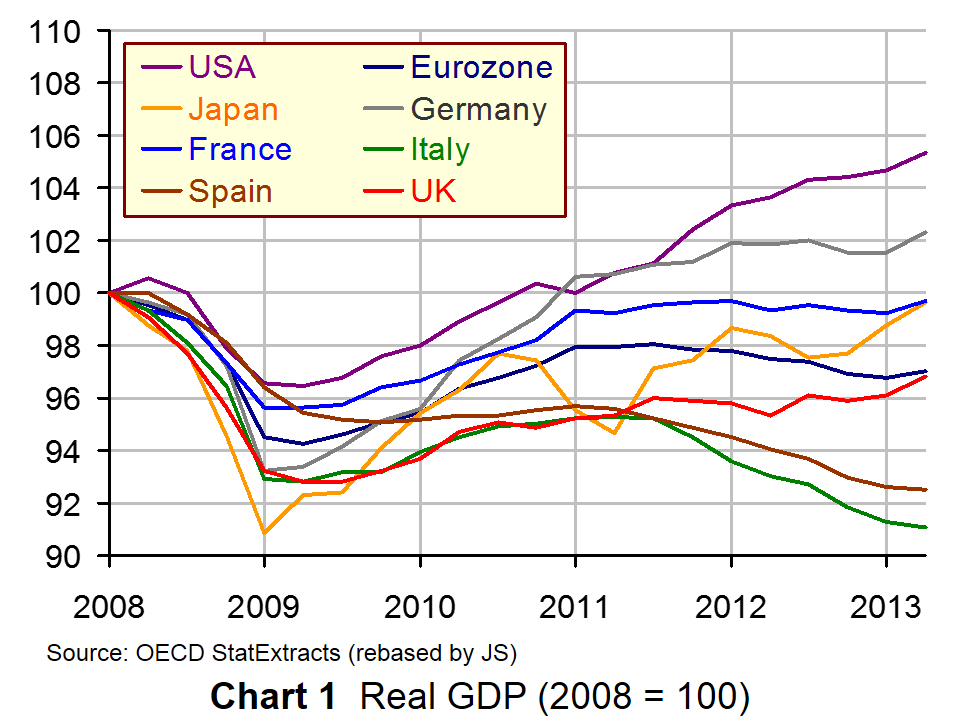 A deep and prolonged recession followed (see Chart 1: click here for a PowerPoint). In response, governments pursued expansionary fiscal policies – at least until worries about rising government deficits and debt caused a lurch to austerity policies. And central banks pursued policies of near zero interest rates and subsequently of quantitative easing. But all the time debate was taking place about how to reform banking to prevent similar crises occurring in the future.
A deep and prolonged recession followed (see Chart 1: click here for a PowerPoint). In response, governments pursued expansionary fiscal policies – at least until worries about rising government deficits and debt caused a lurch to austerity policies. And central banks pursued policies of near zero interest rates and subsequently of quantitative easing. But all the time debate was taking place about how to reform banking to prevent similar crises occurring in the future.
Solutions have included reform of the Basel banking regulations to ensure greater capital adequacy. 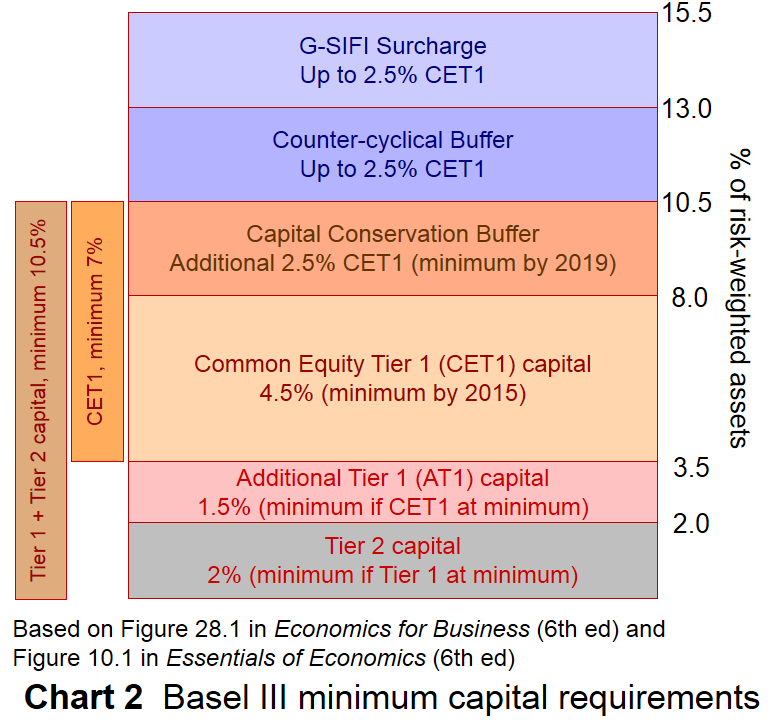 The Basel III regulations (see Chart 2) demand considerably higher capital ratios than the previous Basel II regulations.
The Basel III regulations (see Chart 2) demand considerably higher capital ratios than the previous Basel II regulations.
Other solutions have included proposals to break up banks. Indeed, just this week, the Lloyds Banking Group has hived off 631 of its branches (one sixth of the total) into a newly reformed TSB. Another proposal is to ring-fence the retail side of banks from their riskier investment divisions. In both cases the aim has been to avoid the scenario where banks are seen as too big to fail and can thus rely on governments to bail them out if they run into difficulties. Such reliance can make banks much more willing to take excessive risks. Further details of the new systems now in place are given in the Robert Peston article below.
But many critics maintain that not nearly enough has been done. Claims include:
• The Basel III rules are not tough enough and banks are still being required to hold too little capital.
• Rewards to senior bankers and traders are still excessive.
• The culture of banking, as a result, is still too risk loving in banks’ trading arms, even though they are now much more cautious about lending to firms and individuals.
• This caution has meant a continuing of the credit crunch for many small businesses.
• Higher capital adequacy ratios have reduced bank lending and have thus had a dampening effect on the real economy.
• The so-called ring-fences may not be sufficient to insulate retail banking from problems in banks’ investment divisions.
• Banks are not being required to hold sufficient liquidity to allow them to meet customers’ demands for cash in all scenarios.
• Banks’ reliance on each other still leaves a systemic risk for the banking system as a whole.
• Fading memories of the crisis are causing urgency to tackle its underlying problems to diminish.
• Problems may be brewing in less regulated parts of the banking world, such as the growing banking sector in China.
The following articles look at the lessons of the banking crisis – those that have been learned and those that have not. They look at the measures put in place and assess whether they are sufficient.
Lehman Brothers collapse, five years on: ‘We had almost no control’ The Guardian, Larry Elliott and Jill Treanor (13/9/13)
Lehman Brothers collapse: five years on, we’re still feeling the shockwaves The Guardian, Larry Elliott (13/9/13)
Five years after Lehman, could a collapse happen all over again? The Observer, Larry Elliott and Jill Treanor (15/9/13)
Five years after Lehman, all tickety-boo? BBC News, Robert Peston (9/9/13)
What have we learned from the bank crash? Independent, Yalman Onaran, Michael J Moore and Max Abelson (14/9/13)
We’ve let a good financial crisis go to waste since Lehman Brothers collapsed The Telegraph, Jeremy Warner (12/9/13)
 The Lehman legacy: Lessons learned? The Economist (9/9/13)
The Lehman legacy: Lessons learned? The Economist (9/9/13)
The dangers of debt: Lending weight The Economist (14/9/13)
The Lehman anniversary: Five years in charts The Economist (14/9/13)
Questions
- Why did Lehman Brothers collapse?
- Explain the role of the US sub-prime mortgage market in the global financial crisis of 2007/8.
- In the context of banking, what is meant by (a) capital adequacy; (b) risk-based capital adequacy ratios; (c) leverage; (d) leverage ratios?
- Explain the Basel III rules on (a) risk-based capital adequacy (see the textbook and the chart above); (b) non-risk-based leverage (introduced in 2013: see here for details).
- Explain and comment on the following statement by Adair Turner: ‘We created an over-leveraged financial system and an over-leveraged real economy. We created a system such that even if the direct cost of bank rescue was zero, the impact of their near-failure on the economy was vast.’
- Under what circumstances might the global financial system face a similar crisis to that of 2007/8 at some point in the future?
- Why is there an underlying conflict between increasing banks’ required capital adequacy and ensuring a sufficient supply of credit to consumers and business? What multiplier effects are likely to occur from an increase in the capital adequacy ratio?
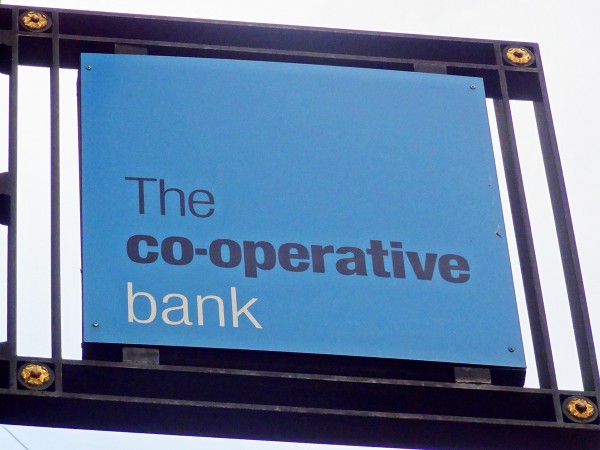 Over the past few years, the term ‘bail-out’ has been a common phrase. But, what about the term ‘bail-in’? The latest bank to face financial ruin is the Co-operative Bank, but instead of turning to the tax-payer for a rescue, £1.5 billion will come from bond holders being offered shares in the bank. This will mean that the bank will become listed on the stock market.
Over the past few years, the term ‘bail-out’ has been a common phrase. But, what about the term ‘bail-in’? The latest bank to face financial ruin is the Co-operative Bank, but instead of turning to the tax-payer for a rescue, £1.5 billion will come from bond holders being offered shares in the bank. This will mean that the bank will become listed on the stock market.
Back in 2009, the Co-operative Bank bought Britannia Building Society and it seems that this was the start of its downfall. It took over many bad mortgage loans and loans to companies, and these played a large part in its current financial difficulties.
In order to rescue the bank and raise the capital needed to absorb current and future losses, without turning to the tax-payer, bond-holders of £1.3 billion of loans to the bank will be asked to swap them for shares and bonds, thus leading to significant losses for them. These bond-holders include 7000 private investors.
Since the financial crisis five years ago, the conventional banking model has seen much criticism and many suggested that the mutual structure of the Co-operative provided a better model, creating trust, due to its many stakeholders, who are not as focused on profitability and returns as those shareholders of a listed bank. However, the problems of the Co-operative seem to have put paid to that idea. The bail-in will mean that the bank is now listed on the stock market and thus will have shareholders expecting returns and profitability. This will undoubtedly change the focus of the bank. Euan Sutherland, the new Chief Executive said:
We are very clear that the bank will remain true to responsible and community-based banking and retain its ethical investment stance … Clearly there are lessons to learn and clearly there will be a time to look back and do that but, to be honest, in the last six weeks, where I have been involved with the Co-operative group, we have focused on driving a very solid future for this bank.
The good news is that the savings of those in the Co-operative are safe and taxpayers will not have to fork out any more money.
Yet, the co-operative structure of the bank has long been praised by customers and government alike. But is it perhaps this structure, which has led to its collapse? Furthermore, will the change in structure that will see it listed on the stock market, lead to a change in its approach to banking? The following articles consider the latest bank to run into difficulties.
Webcast
 Co-op Bank unveils rescue plan to tackle the £1.5bn hole BBC News (17/6/13)
Co-op Bank unveils rescue plan to tackle the £1.5bn hole BBC News (17/6/13)
Articles
Co-op Bank travails show weakness of mutual model Financial Times, Sarah Gordon (21/6/13)
Co-operative Bank to list on stock market in rescue deal The Guardian, Jill Treanor (17/6/13)
Troubled Co-operative Bank unveils rescue plan to plug £1.5bn hole in balance sheet Independent, Nick Goodway (17/6/13)
Co-op Bank announces plan to plug £1.5bn hole Which? (17/6/13)
The Co-operative Bank and the challenge of finding co-op capital The Guardian, Andrew Bibby (13/6/13)
Co-op Bank seeks to fill £1.5bn capital hole Sky News (17/6/13)
Does Co-op Group deserve to keep control of Co-op Bank? BBC News, Robert Peston (9/7/13)
Questions
- Why did the Co-operative Bank move into financial trouble?
- What are the key characteristics of a Mutual? Are they disadvantages or advantages?
- What is a ‘bail-in’? Who will gain and who will lose?
- The Co-operative Bank will now be listed on the stock market. What does this mean?
- What are the advantages and disadvantages of floating a company on the stock market?
- Why are all banks required to hold capital to absorb losses?
 The housing market is crucial in any economy, as it provides so many jobs in related industries. It is frequently a good signal of how buoyant the economy is. With recession in the UK, mortgage rationing continuing and many homeowners having to find 20% deposits to buy a house, many would expect the housing market to be showing signs of trouble.
The housing market is crucial in any economy, as it provides so many jobs in related industries. It is frequently a good signal of how buoyant the economy is. With recession in the UK, mortgage rationing continuing and many homeowners having to find 20% deposits to buy a house, many would expect the housing market to be showing signs of trouble.
And to some extent this is the case. Studies on house prices have clearly shown how unpredictable this market is and prices remain 0.7% below what they were a year ago. However, in August house prices increased, recording their biggest rise in two and a half years, at 1.3%. For many, this rise was a surprise, but came as a welcome relief following the declines in previous months. Despite this rise, analysts have suggested that this trend is unlikely to continue throughout the rest of the year, as the demand for houses remains weak. Robert Gardner, the Chief Economist at Nationwide said:
“Given the difficult economic backdrop, the extent of the rebound in August is a little surprising. However, we should never read too much into one month’s data, especially since monthly price changes have been impacted by a number of one-off factors this year, such as the ending of the stamp duty holiday for first time buyers’.
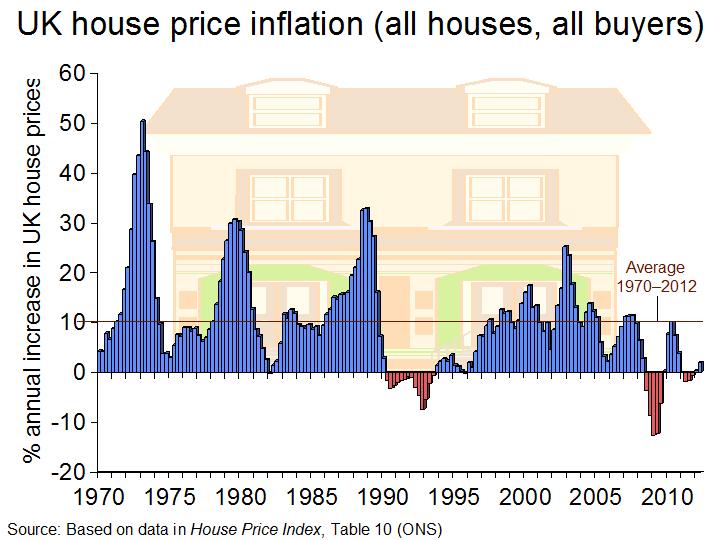 So, what is behind this upward trend? Nationwide’s Chief Economist says that it could be explained by a resilient labour market, where employment has risen in recent months, despite the recession. The labour market undoubtedly has a big effect on the housing market, as mortgages do take up so a large percentage of take-home pay.
So, what is behind this upward trend? Nationwide’s Chief Economist says that it could be explained by a resilient labour market, where employment has risen in recent months, despite the recession. The labour market undoubtedly has a big effect on the housing market, as mortgages do take up so a large percentage of take-home pay.
However, another key factor that affects house prices is the availability of mortgages. The Bank of England and Treasury launched the Funding for Lending Scheme at the beginning of August in a bid to make mortgages cheaper and more easily available. However, analysts suggest that the scheme is yet to have an effect. Furthermore, until deposit requirements are eased, that first step on the property ladder will remain elusive for many people. Mortgage approvals did increase slightly in July, but still remain a major barrier for the housing market to really boom.
The following articles consider this ‘surprising’ rise in house prices and the factors behind it.
Articles
House prices in ‘surprising’ jump, Nationwide says BBC News (31/8/12)
UK house prices record surprise increase Financial Times, Tanya Powley (31/8/12)
Surprise house price rise in August not indicative of market, says Nationwide The Telegraph, Emma Wall (31/8/12)
House prices in surprise rebound Independent, Vicky Shaw (31/8/12)
House prices continue to hold The Economic Voice, Jeff Taylor (31/8/12)
Mortgage approvals still subdued, Bank of England says BBC News (30/8/12)
Banks are pulling back from property – expect prices to fall Money Week, Matthew Partridge (31/8/12)
UK house prices up, as London continues surge Share Cast, Michael Miller (29/8/12)
Data
Lending to Individuals Bank of England 2012
House Price Index Land Registry 2012
UK house prices (links) Economics Network
Questions
- Use a supply and demand diagram to analyse recent trends in the housing market.
- Why is the Bank of England’s lending scheme not having the expected impact on the housing market?
- To what extent do you think the state of the housing market depends on mortgage rationing? Which other factors are likely to affect the housing market?
- In the article from the Economic Voice, the author says that house prices holding as they are is a surprise, because of relatively high inflation and the fact that wages are not keeping pace. Explain the economic thinking behind this view.
- The Chief Economist at Nationwide has said that the future of the housing market depends heavily on what happens to the labour market. Why is this the case?
- Why have mortgages been rationed and minimum deposit requirements been increased?
- Why is the housing market so important for the economy?
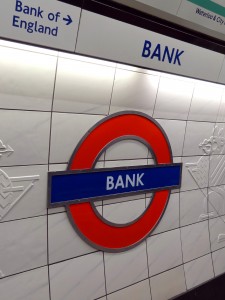 On 2 May 2012, Sir Mervyn King, Governor of the Bank of England, gave the BBC Today Prgramme’s public lecture. In it, he reflected on the causes and aftermath of the banking crisis of 2007/8.
On 2 May 2012, Sir Mervyn King, Governor of the Bank of England, gave the BBC Today Prgramme’s public lecture. In it, he reflected on the causes and aftermath of the banking crisis of 2007/8.
He said that the main cause of the banking crisis was the risky behaviour of the banks themselves – behaviour that they had been allowed to get away with becuase regulation was too light. The cause was not one of inappropriate fiscal and monetary policy.
According to Dr King, there had been no classical macroeconomic boom and bust. True there had been a bust, but there was no preceding boom. Economic growth had not been unsustainable in the sense of being persistently above the potential rate. In other words, the output gap had been close to zero. As Mervyn King puts it
Let me start by pointing out what did not go wrong. In the five years before the onset of the crisis, across the industrialised world growth was steady and both unemployment and inflation were low and stable. Whether in this country, the United States or Europe, there was no unsustainable boom like that seen in the 1980s; this was a bust without a boom.
In terms of monetary policy, inflation had been on track and interest rates were not too low. And as for fiscal policy, government borrowing had been within the Golden Rule, whereby, over the cycle, the goverment borrowed only to invest and kept a current budget balance. Indeed, the period of the late 1990s and early to mid 2000s had become known as the Great Moderation.
So what went wrong? Again in the words of Dr King:
In a nutshell, our banking and financial system overextended itself. That left it fragile and vulnerable to a sudden loss of confidence.
The most obvious symptom was that banks were lending too much. Strikingly, most of that increase in lending wasn’t to families or businesses, but to other parts of the financial system. To finance this, banks were borrowing large amounts themselves. And this was their Achilles’ heel. By the end of 2006, some banks had borrowed as much as £50 for every pound provided by their own shareholders. So even a small piece of bad news about the value of its assets would wipe out much of a bank’s capital, and leave depositors scurrying for the door. What made the situation worse was that the fortunes of banks had become closely tied together through transactions in complex and obscure financial instruments. So it was difficult to know which banks were safe and which weren’t. The result was an increasingly fragile banking system.
But doesn’t his imply that regulation of the banking system had failed? And if so why? And have things now been fixed – so that banks will no longer run the risk of failure? Dr King addresses this issue and others in his speech and also in his interview the next day for the Today Programme, also linked to below.
Podcasts
The Today Programme Lecture BBC Radio 4, Sir Mervyn King (2/5/12) (Transcript of speech)
Also on YouTube at Governor’s Today Programme lecture, 2 May 2012
Sir Mervyn King: The full interview BBC Today Programme, Sir Mervyn King talks to Evan Davis (3/5/12)
Sir Mervyn King analysis ‘verging on delusional’ BBC Today Programme, Dylan Grice and Ngaire Woods (3/5/12)
Articles
Sir Mervyn King rejects criticism for crisis BBC News (3/5/12)
The boom and bust of Mervyn King BBC News, Robert Peston (3/5/12)
Sir Mervyn King admits BoE failed over financial crisis The Telegraph, Philip Aldrick (3/5/12)
Sir Mervyn King admits: we did too little to warn of economic crisis Guardian, Larry Elliott (2/5/12)
King Says BOE Will Risk Unpopularity to Prevent Crises Bloomberg, Jennifer Ryan and Scott Hamilton (3/5/12)
Data
Economic Outlook Annex Tables OECD (See Annex Tables 1, 10, 14, 18, 27, 28, 32, 33, 61 and 62)
Statistical Interactive Database Bank of England (See for example, A Money and Lending: counterparts to changes in M4, alternative presentation > Seasonally adjusted > Public sector contribution > PSNCR)
Questions
- Why was the period of the late 1990s and early to mid 2000s described as the Great Moderation?
- Chart the size of the output gap, the rate of inflation and public-sector deficits as a percentage of GDP in the UK and other major economies from 1995 to 2007. Is this evidence of the Great Moderation?
- To what extent would evidence of house prices, consumer debt, bank lending and the balance of trade deficit suggest that there was indeed a boom from the mid 1990s to 2007?
- What, according to Dr King were the main causes of the credit crunch?
- What, with hindsight, should the Bank of England have done differently?
- What UK body was responsible for regulating banks in the run up to the credit crunch? Why might its regulation be described as ‘light touch’?
- In what sense was there a moral hazard in central banks being willing to bail out banks?
- What banking reforms have taken place or will take place in the near future? Will they address the problems identified by Dr King and prevent another banking crisis ever occurring again?
 Insolvencies in England and Wales have fallen to their lowest level since 2005, official records show. The Insolvency Service indicates that bankruptcy, individual voluntary arrangements and debt relief orders have fallen, with the largest and worst form of bankruptcy falling by 22.5 per cent compared to the same period in 2014. There has also been a fall in corporate insolvencies back to pre-crisis levels.
Insolvencies in England and Wales have fallen to their lowest level since 2005, official records show. The Insolvency Service indicates that bankruptcy, individual voluntary arrangements and debt relief orders have fallen, with the largest and worst form of bankruptcy falling by 22.5 per cent compared to the same period in 2014. There has also been a fall in corporate insolvencies back to pre-crisis levels.






